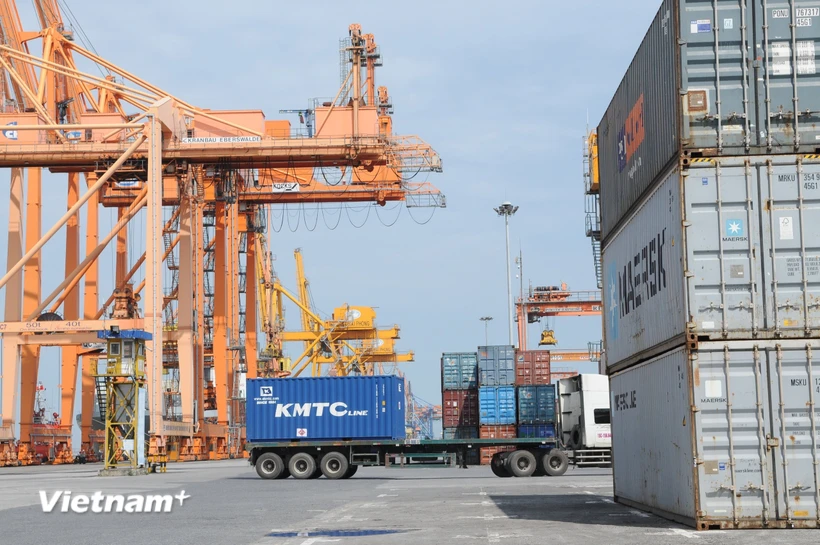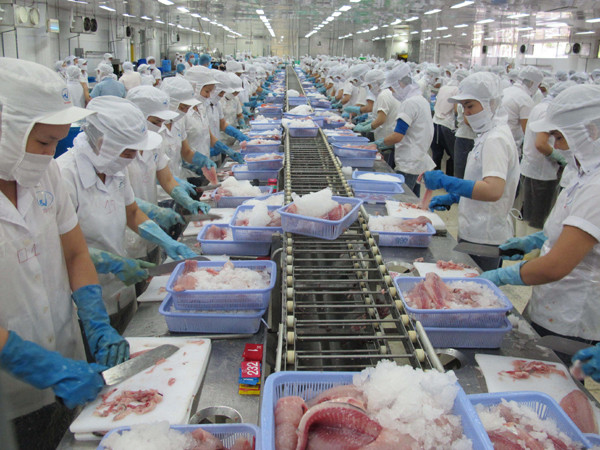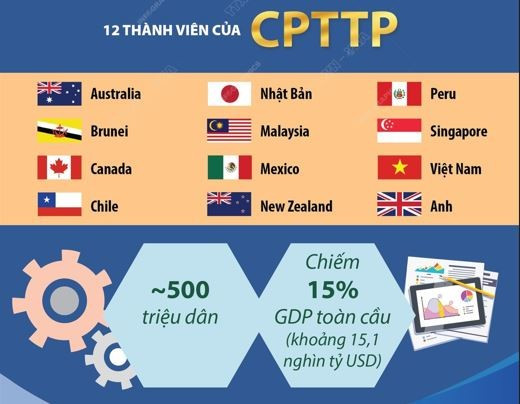In 2024, exports of many products to CPTPP member markets will record positive growth rates and CPTPP will continue to be an important driving force to boost Vietnam's exports to this market.
The Comprehensive and Progressive Agreement for Trans-Pacific Partnership (CPTPP) officially took effect in Vietnam from January 14, 2019. After 6 years of implementation, CPTPP is considered one of the agreements that brings high efficiency to Vietnamese goods exported to this market.
Along with the 11 original member countries, CPTPP officially took effect with the United Kingdom from December 15, 2024. Opportunities and challenges continue to open up for Vietnam in 2025 as well as the 12 member economies of the trade bloc accounting for 15% of the world's total GDP and a population of more than 500 million people.
Affirming position in the market
In 2024, despite many fluctuations in the world economy, Vietnam's import and export activities to the CPTPP market still achieved a fairly good growth rate.
Synthesizing information on the cooperation and trade situation between Vietnam and CPTPP member markets by the Center for Industry and Trade Information (Ministry of Industry and Trade) shows that in 2024, two-way trade turnover between Vietnam and the CPTPP market is estimated to reach 102.1 billion USD, an increase of 6.8% compared to 2023, accounting for 13.1% of the total import-export turnover.

The highlight is that each industry and export sector to markets in the CPTPP bloc has had spectacular growth, higher each year than the previous year, and many groups of goods have a high rate of using preferential CPTPP certificates of origin (C/O). In particular, Vietnamese enterprises have effectively taken advantage of incentives from CPTPP in markets in the Americas such as Canada, Mexico and Peru - countries that have had trade agreements with Vietnam for the first time under CPTPP.
Ms. Vo Thi Hong Anh, Deputy Director of the European-American Market Department (Ministry of Industry and Trade) said that since the CPTPP agreement came into effect, some of Vietnam's key export products such as phones, electronics, seafood, wooden furniture, etc. have gradually affirmed their position in the markets of these CPTPP countries.
Just counting shrimp alone, Vietnam is currently the supplier of about 35% of shrimp to the Canadian market, or for pangasius, Mexico is currently one of the three largest export markets for Vietnamese pangasius...
From a business perspective, Ms. Le Hang, Communications Director, Vietnam Association of Seafood Exporters and Producers (VASEP) informed that the increase in market share of Vietnamese seafood in these markets shows that the competitive strength of Vietnamese seafood products has been greatly supported by the CPTPP agreement.
For example, in Canada, Vietnam's market share has increased from 7-8% in the previous period to 10%, in which shrimp alone has increased from 18% to 25% and Vietnamese shrimp is number 1 in Canada. Or in Australia, Vietnam's shrimp also accounts for an overwhelming market share of 70%, double the period before Vietnam joined CPTPP...

According to Ms. Nguyen Thi Huong, Director of Golden Cashew Company Limited, the company has targeted a number of markets in the CPTPP bloc and currently the company's cashew products have been exported to Australia, Japan, Brunei, the UK, etc.
Meanwhile, the agricultural and food products, textiles, footwear, and key industrial export products of Vietnam have taken full advantage of incentives from the CPTPP to increase exports and affirm the quality and advantages of Vietnamese goods in this market.
Mr. Luu Van Khang, Trade Counselor of Mexico, expressed his joy when seeing Vietnamese products such as clothes, shoes, tables, chairs, plastic products, etc. being sold in large supermarkets in Mexico. Food products such as fish, vermicelli, rice noodles, pho, rice paper, etc. have been sold in large and small supermarkets in this market. In particular, many consumers rate Vietnamese products as having good quality, Vietnamese food is very delicious, etc.
Adapting to move deeper in the value chain
In 2024, exports of many goods to CPTPP member markets will record positive growth rates, in which CPTPP continues to be an important driving force to boost Vietnam's exports to this market.
The assessment of the Center for Industry and Trade shows that the structure of export goods to CPTPP member markets in the past year focused on the manufacturing and processing industry group with the top 6 items all belonging to this group, including: machinery, equipment, tools, other spare parts; textiles; computers, electronic products and components; phones of all kinds and components; means of transport and spare parts and footwear of all kinds. These are also the groups of goods that bring the biggest growth momentum in exporting goods to the CPTPP market.
Because the group of 6 products alone accounts for 59% of Vietnam's total export turnover to this market. Compared to 2023, the export turnover of these products all increased, in which computers, electronic products and components are the group of products that recorded the highest growth rate, with an estimated export turnover of 5.7 billion USD, an increase of 30.9% over the previous year and accounting for 10.3% of the total export turnover, higher than the proportion of 8.7% in 2023.
However, there are still many industries that are still exporting raw products, with a very small proportion to the CPTPP market. Mr. Le Phu Cuong, Vietnam Trade Counselor in Malaysia, informed that in recent years, Vietnamese products such as rice, coffee, and cashew nuts have increased strongly. However, many Vietnamese agricultural products exported to Malaysia in raw form are still high, such as 5% broken rice, coffee beans, etc.
It can be seen that the export potential to the CPTPP market with about 500 million people is very large. According to Mr. Ngo Chung Khanh, Deputy Director of the Multilateral Trade Policy Department (Ministry of Industry and Trade), the room for Vietnamese goods to penetrate deeper into CPTPP markets, especially in the Americas such as Canada, Mexico and Peru is extremely large, because there are products in which Vietnam only accounts for about 3-5% of the market share in these markets.
Many products exported to CPTPP with preferential certificates of origin (C/O) only account for about 5% of total export turnover to this bloc. The CPTPP coming into effect from the end of 2024 in the UK opens up a large export market for Vietnamese goods in this market as well as markets with which the UK already has FTAs.

Mr. Ngo Chung Khanh assessed that the UK joining the CPTPP will create more markets for Vietnam because during the CPTPP negotiations, the Ministry of Industry and Trade reached an agreement to open more commitments and open more market access for Vietnam in addition to existing bilateral FTAs, especially the seafood industry has had great advantages when the commitment of the UK joining the CPTPP officially took effect.
“This is one of the bright spots of the CPTPP agreement and there are currently a number of economies applying to join the CPTPP such as Costa Rica, Ecuador, Uruguay... showing that the role of the CPTPP is growing stronger and will certainly create new motivations for businesses and investors to pay more attention to CPTPP members, especially Vietnam,” said Mr. Ngo Chung Khanh.
Experts also said that the CPTPP agreement brings opportunities for exporting goods because the market is expanded. However, the CPTPP is a new generation free trade agreement with high standards, requiring continuous efforts from Vietnamese enterprises to meet market requirements.
Mr. Vu Duc Giang, Chairman of the Vietnam Textile and Apparel Association, emphasized that CPTPP is an FTA that creates innovation and breakthroughs for the development and integration of the Vietnamese economy globally, including the textile and garment industry. CPTPP has given the Vietnamese textile and garment industry the opportunity to access new markets such as Canada, Australia, New Zealand, etc., and also helps Vietnamese textile and garment enterprises adapt to the purchasing methods of importers in this economic bloc.
In addition, CPTPP requires certificates of origin, helping businesses improve the quality of production from input materials. Greening is a condition for Vietnamese businesses to dominate the game in CPTPP and this is certainly not only a requirement from the CPTPP market but also from all of Vietnam's export markets./.









![Detailed Guide to Chemical Import Procedures [Updated 2025]](https://songwinlog.net/thumbs/355x266x1/upload/news/ve-tay-hinh-tron-logo-2-3776.png)











